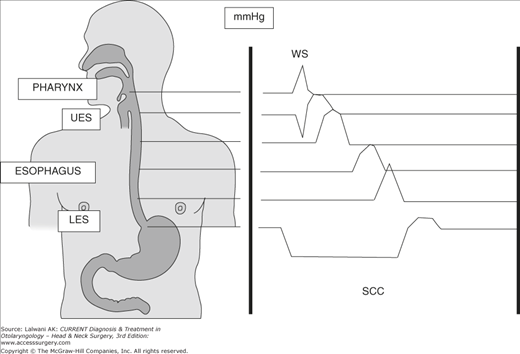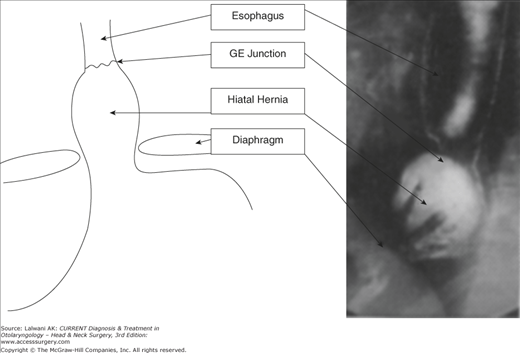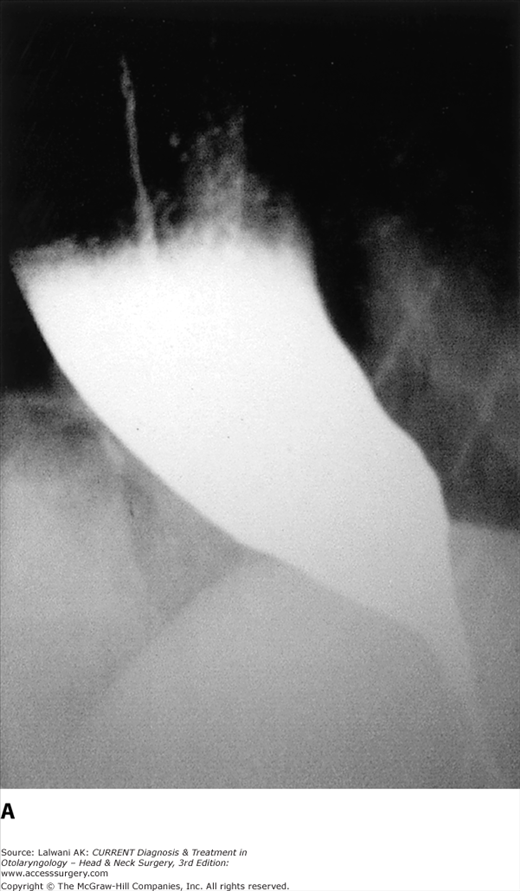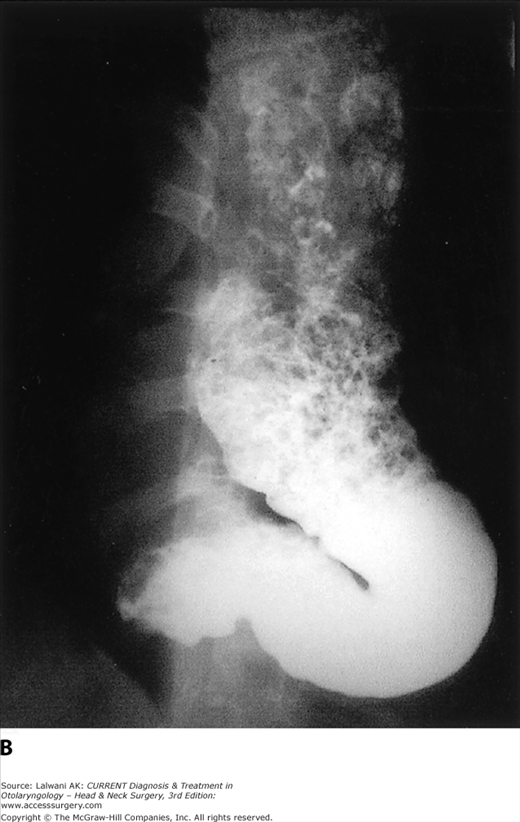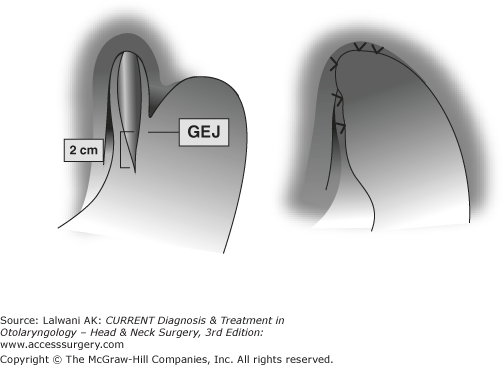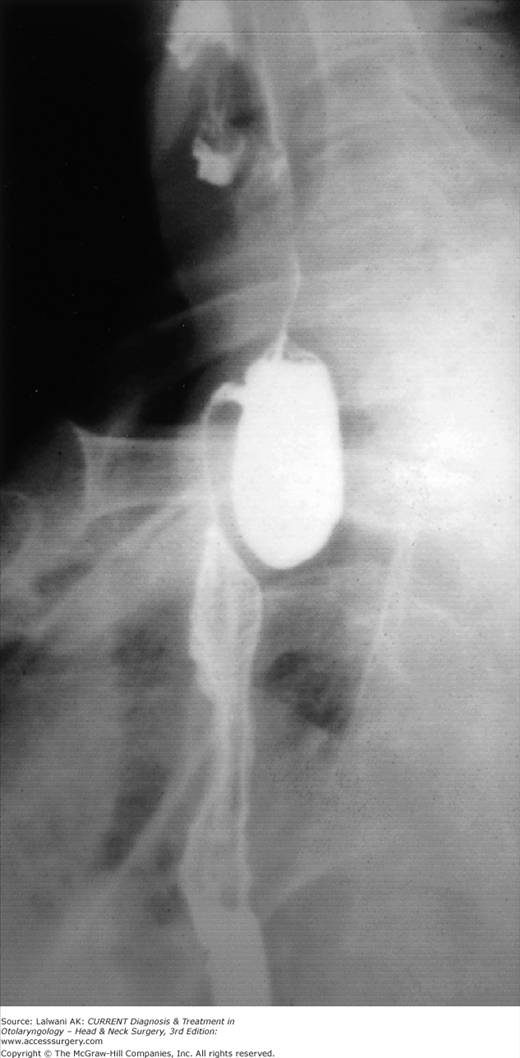Anatomy
The esophagus is a muscular tube that extends from the level of the sixth cervical vertebra to the 11th thoracic vertebra, spanning three anatomic regions. The cervical esophagus lies left of the midline and posterior to the larynx and trachea. This portion receives its blood supply from branches of the inferior thyroid arteries and drains into the inferior thyroid veins. The upper portion of the thoracic esophagus passes behind the tracheal bifurcation and the left mainstem bronchus. The lower portion of the thoracic esophagus passes behind the left atrium and then enters the abdomen through the esophageal hiatus of the diaphragm.
The thoracic esophagus is supplied by the bronchial arteries (upper portion) and the branches of the thoracic aorta (midportion) and drains into the hemiazygos and azygos veins. The abdominal esophagus ends at the level of the junction with the stomach. The lowermost thoracic esophagus and the abdominal esophagus are nourished by the branches of the left gastric and inferior phrenic arteries and drain into the left gastric veins. Abundant lymphatics form a dense submucosal plexus. Lymph from the upper esophagus drains mostly in the cervical and paratracheal lymph nodes, whereas the lower thoracic and abdominal esophagus drains preferentially into the retrocardiac and celiac nodes.
The architecture of the esophageal wall consists of three layers. The mucosa is made of squamous epithelium overlying a lamina propria and a muscularis mucosa. The submucosa is made of elastic and fibrous tissue and is the strongest layer of the esophageal wall. The esophageal muscle is composed of an inner circular and outer longitudinal layer. The upper third of the esophageal musculature consists of skeletal muscle and the lower two thirds consist of smooth muscle. The upper esophageal sphincter (UES) is formed by the cricopharyngeus muscle along with the inferior constrictors of the pharynx and fibers of the esophageal wall. The lower esophageal sphincter (LES) is not a distinct anatomic structure. Unlike the remainder of the gastrointestinal tract, the esophagus does not have a serosal layer.
Physiology
The coordinated activity of the UES, the esophageal body, and the LES is responsible for the motor function of the esophagus.
The UES receives motor innervation directly from the brain (ie, the nucleus ambiguus). Contributions from the inferior pharyngeal constrictor, cricopharyngeus, and cervical esophageal form this muscular sphincter, with the primary contributor being the cricopharyngeus. The sphincter is continuously in a state of tonic contraction, with a resting pressure of approximately 60–100 mm Hg. The sphincter prevents both the passage of air from the pharynx into the esophagus and the reflux of esophageal contents into the pharynx. During swallowing, a food bolus is moved by the tongue into the pharynx, which contracts while the UES relaxes. Supra- and infrahyoid musculature contribute to pulling the laryngotracheal apparatus away from the spinal column and further dilating the UES. After the food bolus has reached the esophagus, the UES regains its resting tone (Figure 36–1).
When food passes through the UES, a contraction is initiated in the upper esophagus, which progresses distally toward the stomach. The wave initiated by swallowing is referred to as primary peristalsis. It travels at a speed of 3–4 cm/s and reaches peak amplitudes of 60–140 mm Hg in the distal esophagus.
The LES measures 3–4 cm in length and is tonic, with resting pressure ranges between 15 and 24 mm Hg. At the time of swallowing, the LES relaxes for 5–10 s to allow the food bolus to enter the stomach, and then it regains its resting tone (see Figure 36–1). The LES relaxation is mediated by vasoactive intestinal polypeptide and nitric oxide, both nonadrenergic and noncholinergic neurotransmitters. The resting tone depends mainly on intrinsic myogenic activity. The LES has a tendency to relax periodically at times, independent from swallowing. These periodic relaxations are called transient LES relaxations to distinguish them from relaxations triggered by swallows. The cause of these transient relaxations is not known, but gastric distention probably plays a role.
Transient LES relaxations account for the small amount of physiologic gastroesophageal reflux present in any individual and are also the most common cause of reflux in patients with gastroesophageal reflux disease (GERD). A decrease in the length or the pressure (or both) of the LES is responsible for abnormal reflux in the remaining patients. Overall, it is thought that although transient LES relaxation is the most common mechanism of reflux in patients with either absent or mild esophagitis, the prevalence of a mechanically defective sphincter (ie, hypotensive, short, or both) increases in patients with more severe esophagitis. The crus of the esophageal hiatus of the diaphragm contributes to the resting pressure of the LES. The pinchcock action of the diaphragm is particularly important because it protects against reflux caused by sudden increases of intraabdominal pressure, such as with coughing or bending. This synergistic action of the diaphragm is lost when a sliding hiatal hernia is present, since the gastroesophageal junction is displaced above the diaphragm (Figure 36–2).
Benign Disorders of the Esophagus
- Dysphagia
- Regurgitation
- Radiologic evidence of distal esophageal narrowing
- Absence of esophageal peristalsis on manometry.
Esophageal achalasia is a primary esophageal motility disorder characterized by the absence of esophageal peristalsis and increased pressure of the LES, which fails to relax completely in response to swallowing. The disease is rare, with an incidence of about 1 in 100,000 individuals. It affects men more than women, and it can occur at any age.
The cause of esophageal achalasia is unknown. A degeneration of the myenteric plexus of Auerbach has been documented, with loss of the postganglionic inhibitory neurons. These neurons contain nitric oxide and vasoactive intestinal polypeptide, which mediate LES relaxation. Because the postganglionic cholinergic neurons are spared, there is unopposed cholinergic stimulation that can result in increased LES resting pressure and insufficient relaxation. However, it is primarily decreased esophageal motility and incomplete relaxation that characterizes achalasia, as not all patients have a hypertensive LES.
Dysphagia, for solids and liquids, is the most common symptom, occurring in over 90% of patients. Most patients adapt to this symptom by changing their diet and are able to maintain a stable weight, whereas others experience a progressive increase in dysphagia that eventually leads to weight loss. Regurgitation is the second most common symptom and it is present in about 75% of patients. It occurs more often in the supine position and may lead to the aspiration of undigested food. Heartburn is present in about 50% of patients, and it is caused by stasis and fermentation of undigested food in the distal esophagus. Chest pain also occurs in 40% of patients. The symptoms of heartburn and chest pain can erroneously be attributed to GRED if proper studies are not performed.
In evaluating a patient with dysphagia, a barium swallow should be the first test performed. It usually shows a narrowing at the level of the gastroesophageal junction (Figure 36–3A). A dilated, sigmoid esophagus may be present in patients with long-standing achalasia (Figure 36–3B). An endoscopy should be performed to rule out a tumor of the esophagogastric junction and gastroduodenal pathology.
Esophageal manometry is the key test for establishing the diagnosis of esophageal achalasia. The classic manometric findings are (1) absence of esophageal peristalsis and (2) a hypertensive LES that relaxes only partially in response to swallowing.
In patients who have undergone pneumatic dilatation or a myotomy, ambulatory pH monitoring should always be performed to rule out abnormal gastroesophageal reflux; if present, it should be treated with acid-reducing medications.
Benign strictures caused by gastroesophageal reflux, eosinophilic esophagitis, and esophageal carcinoma may mimic the clinical presentation of achalasia. Sometimes an infiltrating tumor of the cardia can mimic not only the clinical and radiologic presentation of achalasia, but also the manometric profile. This condition is known as secondary achalasia or pseudoachalasia and should be suspected in patients older than 60 years of age who present with a recent onset of dysphagia and excessive weight loss. An endoscopic ultrasound or a computed tomography (CT) scan can help to establish the diagnosis.
The aspiration of retained and undigested food can cause repeated episodes of pneumonia. Achalasia is also a risk factor for esophageal cancer. Squamous cell carcinoma is probably due to the continuous irritation of the mucosa by the retained and fermenting food. However, adenocarcinoma can occur in patients who develop gastroesophageal reflux after either pneumatic dilatation or myotomy.
Therapy is palliative and is directed toward relieving symptoms by decreasing the outflow resistance caused by the dysfunctional LES. Because peristalsis is absent, gravity becomes the key factor that allows the emptying of food from the esophagus into the stomach. Several treatment modalities are available to achieve this goal.
Calcium channel blockers are used to decrease LES pressure. However, only 10% of patients benefit from this treatment. It should be used primarily in elderly patients who have contraindications to either pneumatic dilatation or surgery.
An intrasphincteric injection of botulinum toxin is used to block the release of acetylcholine at the level of the LES, therefore restoring the balance between excitatory and inhibitory neurotransmitters. This treatment, however, is of limited value since only 30% of treated patients still experience a relief of dysphagia 2.5 years later. It should be used primarily in elderly patients who are poor candidates for dilatation or surgery.
Pneumatic dilatation has been the main form of treatment for many years. The initial success rate is between 70% and 80%, but it decreases to 50% 10 years later, even after multiple dilatations. The perforation rate is approximately 5%. If a perforation occurs, patients are taken emergently to the operating room, where closure of the perforation and a myotomy are performed through a left thoracotomy. The incidence of abnormal gastroesophageal reflux is about 25%. Patients who fail pneumatic dilatation are usually treated by a Heller myotomy.
A laparoscopic Heller myotomy and partial fundoplication is the procedure of choice for esophageal achalasia. The operation consists of a controlled division of the muscle fibers (ie, a myotomy) of the lower esophagus (5 cm) and proximal stomach (2 cm), followed by a partial fundoplication to prevent reflux (Figure 36–4). Patients remain in the hospital for 24–48 h, and return to regular activities in about 2 weeks. The operation effectively relieves symptoms in 85–95% of patients, and the incidence of postoperative reflux is between 10% and 15%. Because of the excellent results, short hospital stay, and fast recovery time, a laparoscopic Heller myotomy and partial fundoplication is considered today to be the primary treatment modality for esophageal achalasia.
A laparoscopic Heller myotomy allows for the excellent relief of symptoms in the majority of patients and should be preferred to pneumatic dilatation whenever surgical expertise is available. Botulinum toxin and medications should be used only in patients who are not candidates for pneumatic dilatation or laparoscopic Heller myotomy. Periodic follow-up by endoscopy is recommended to rule out the development of esophageal cancer.
Pharyngoesophageal Diverticulum (Zenker Diverticulum)
- Dysphagia
- Regurgitation of undigested food (with risk of aspiration)
- Gurgling sounds in the neck
- Halitosis.
Zenker diverticulum originates from the posterior wall of the esophagus in a triangular area of weakness, limited inferiorly by the cricopharyngeus muscle and superiorly by the inferior constrictor muscles (ie, the Killian triangle). As the diverticulum enlarges, it tends to deviate from the midline, mostly to the left (Figure 36–5).
Zenker diverticulum results from either a lack of coordination between the pharyngeal contraction and the opening of the UES or a hypertensive UES (including cricopharyngeal spasm). Because of the increased intraluminal pressure, there is progressive herniation of mucosa and submucosa through the Killian triangle.
Dysphagia is the most common symptom. The regurgitation of undigested food from the diverticulum often occurs and can lead to aspiration both into the tracheobronchial tree and pneumonia. Patients frequently have halitosis and can hear gurgling sounds in the neck. About 30–50% of patients have associated GERD.
A barium swallow can clearly show the position and size of the diverticulum. It can also show a hiatal hernia.
Esophageal manometry can demonstrate a lack of coordination between the pharynx and the cricopharyngeus muscle, as well as a hypertensive UES. In addition, it can show a hypotensive LES and abnormal esophageal peristalsis. Ambulatory pH monitoring can determine whether abnormal esophageal acid exposure is present.
The differential diagnosis of Zenker diverticulum includes esophageal stricture, achalasia, esophageal cancer, and pneumonia. A sudden increase in pain and dysphagia symptoms or hematemesis in a patient with an existing Zenker diverticulum should raise suspicion for a squamous cell carcinoma arising within the diverticulum, which is a rare but reported event. Other diverticula can occur in the pharyngeal (pharyngeal pouch) and upper esophageal (Killiam–Jamieson diverticulum) areas and should be distinguished because the treatment is different.
The classic treatment consists of excision of the diverticulum and myotomy of the cricopharyngeus muscle, including the upper 3 cm of the posterior esophageal wall through a cervical incision. For small diverticula (ie, <2 cm), myotomy alone is sufficient.
In more recent years, transoral endoscopic management has gained popularity, using either rigid or flexible endoscopy. The wall of the diverticulum and the cricopharyngeus muscle is divided with a stapling device, electrocautery, or laser. Use of a stapling device has been preferred for diverticula between 3 and 6 cm because it effectively seals the cut edges of the wound as it divides the sac. The stapling device is mechanically limited in short segment (<3 cm) diverticula due to inability to advance the staple line to the end of the sac and thus incomplete division of the party wall, and this can also result in recurrence in patients with longer sacs. Division of short- and long-segment diverticula can be performed with CO2 laser or electrocautery, with some authors advocating mucosal closure with an endoscopic suturing device following division. Endoscopic injection of botulinum toxin into the cricopharyngeus has also been used with some success for small diverticula.
If GERD is present, it should be treated aggressively with either proton pump inhibitors or fundoplication in order to avoid aspiration into the tracheobronchial tree.

